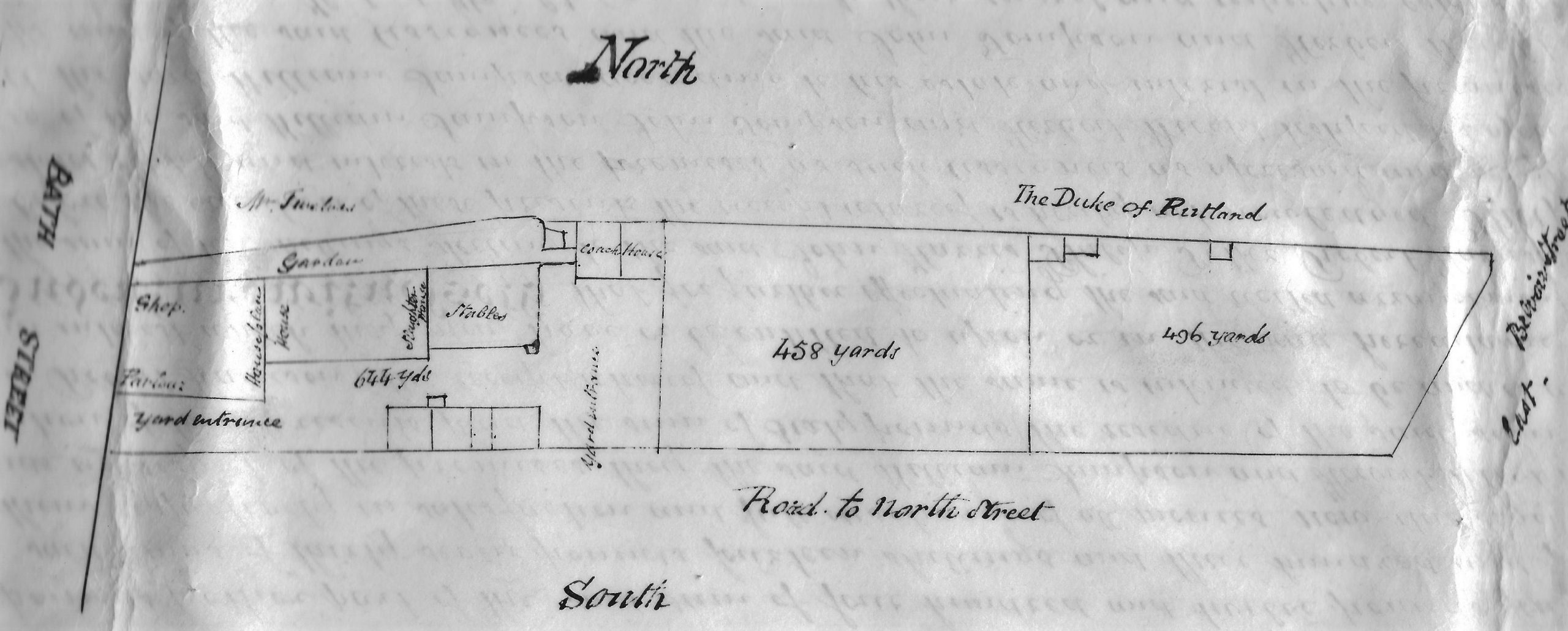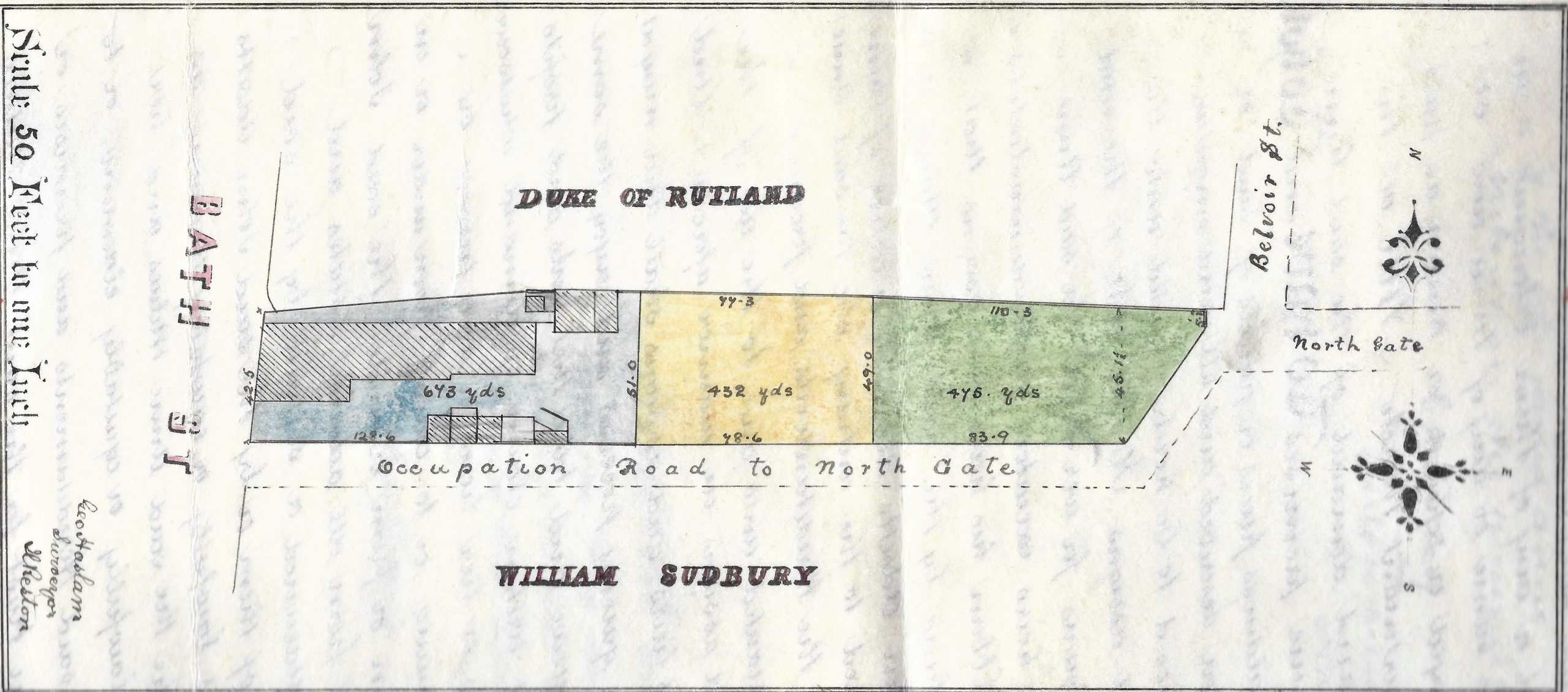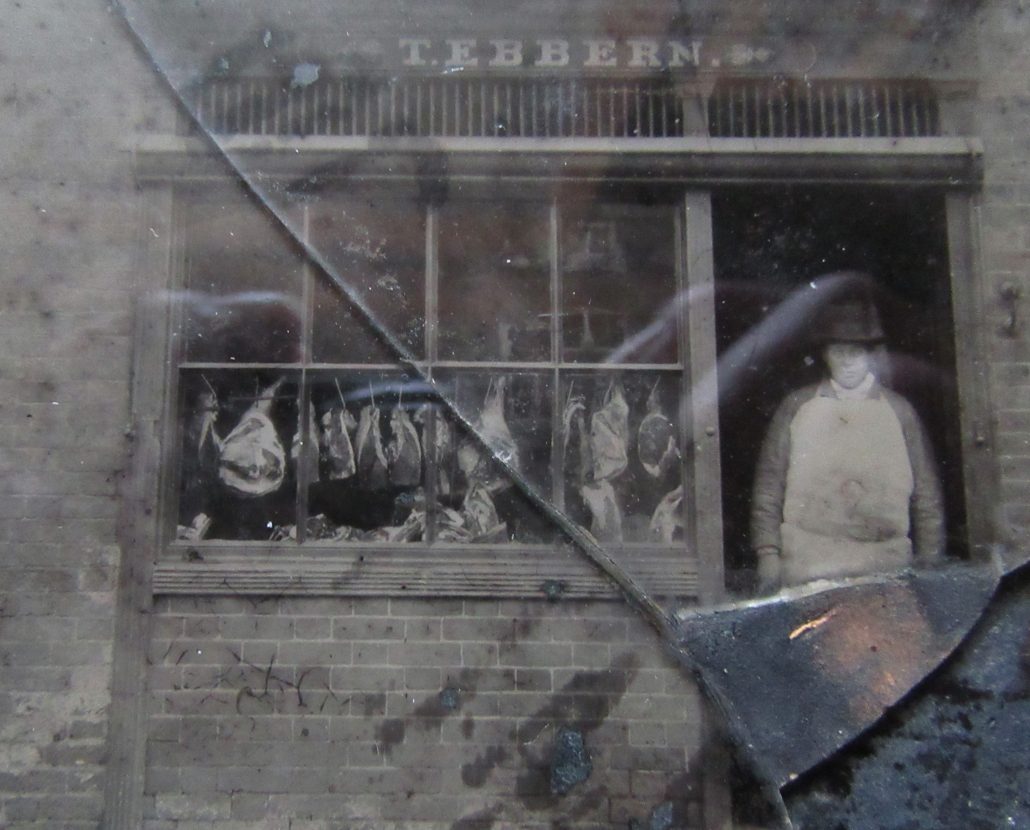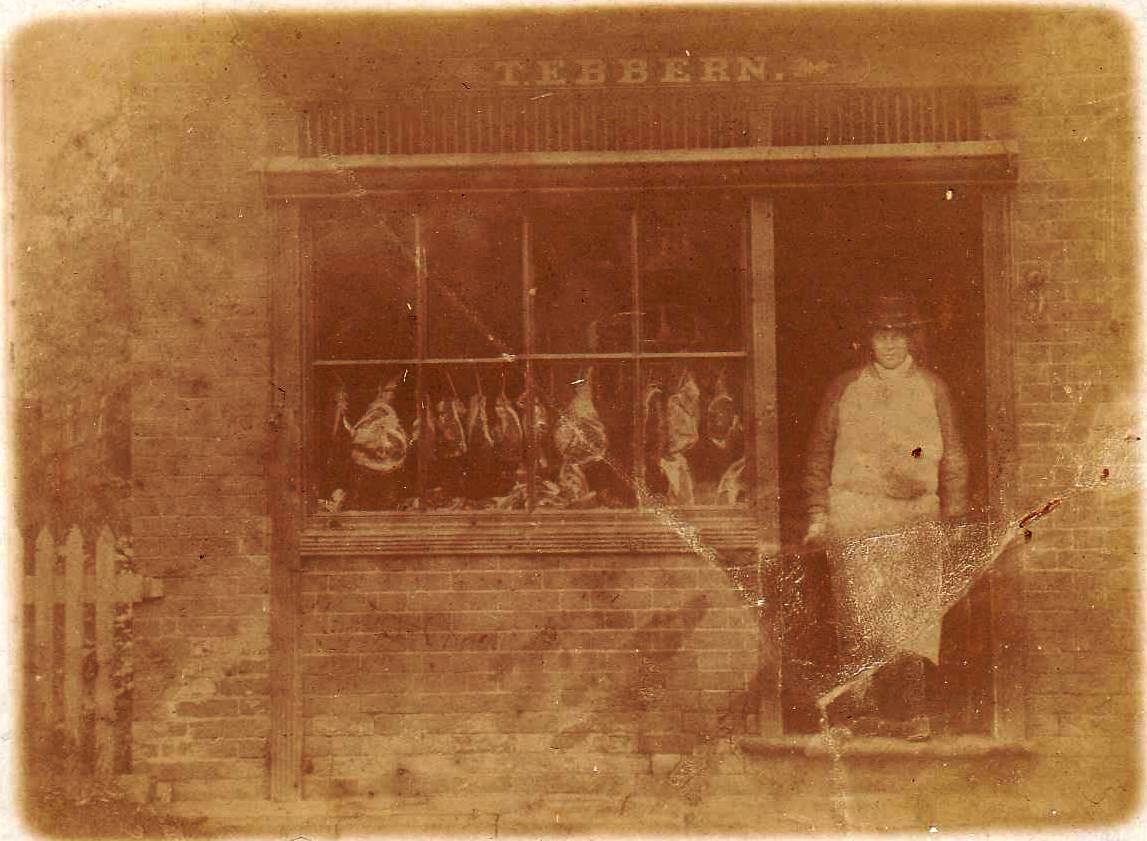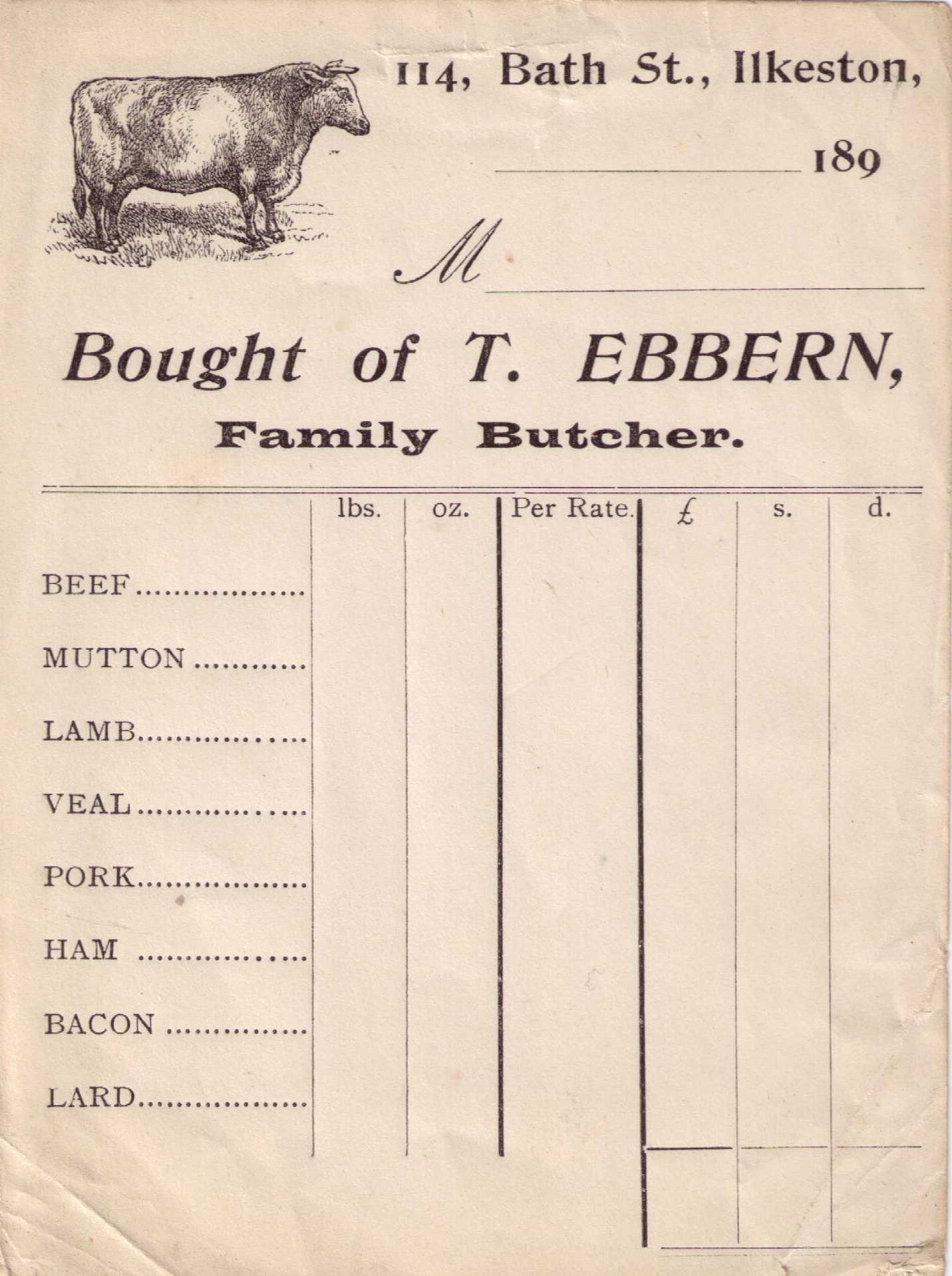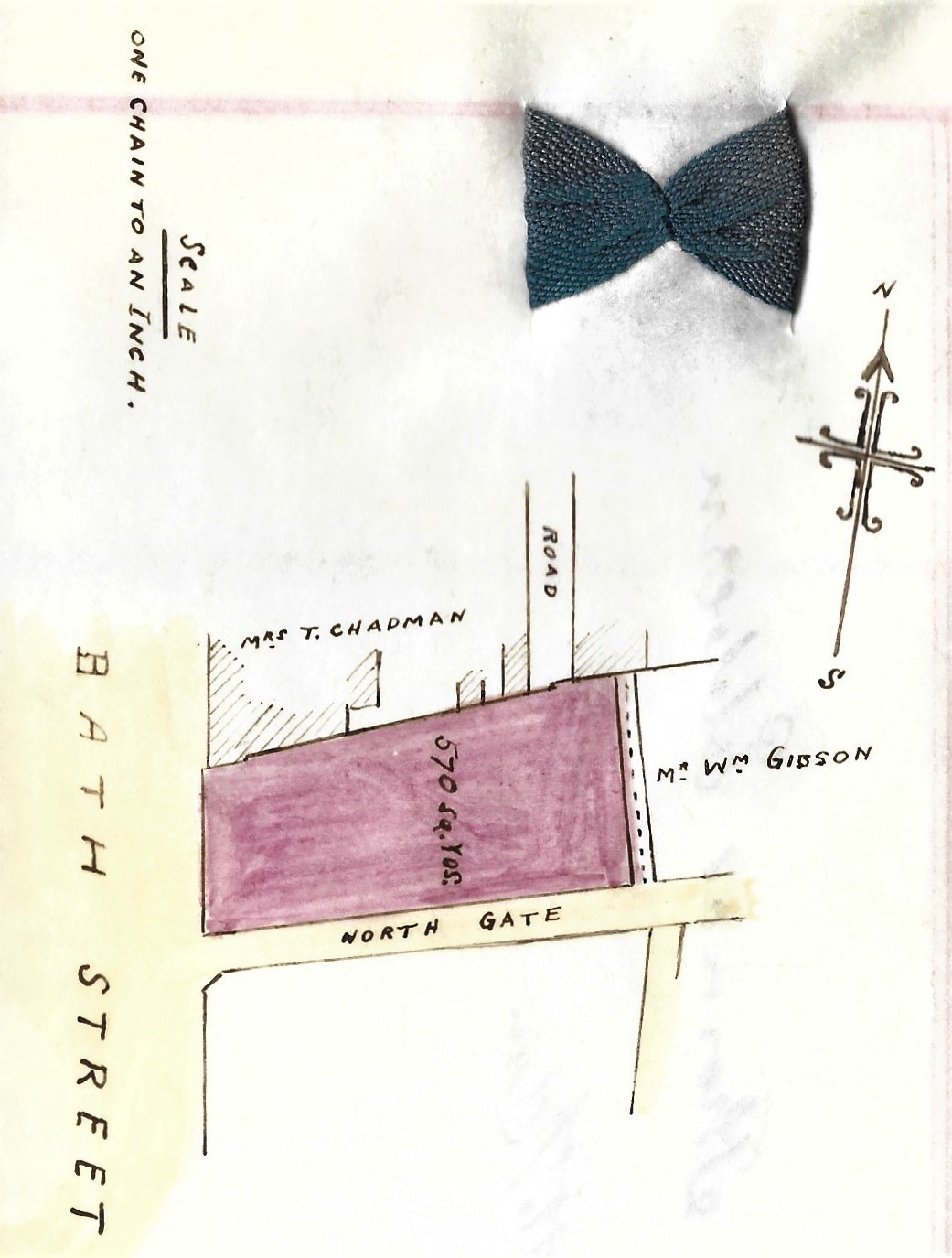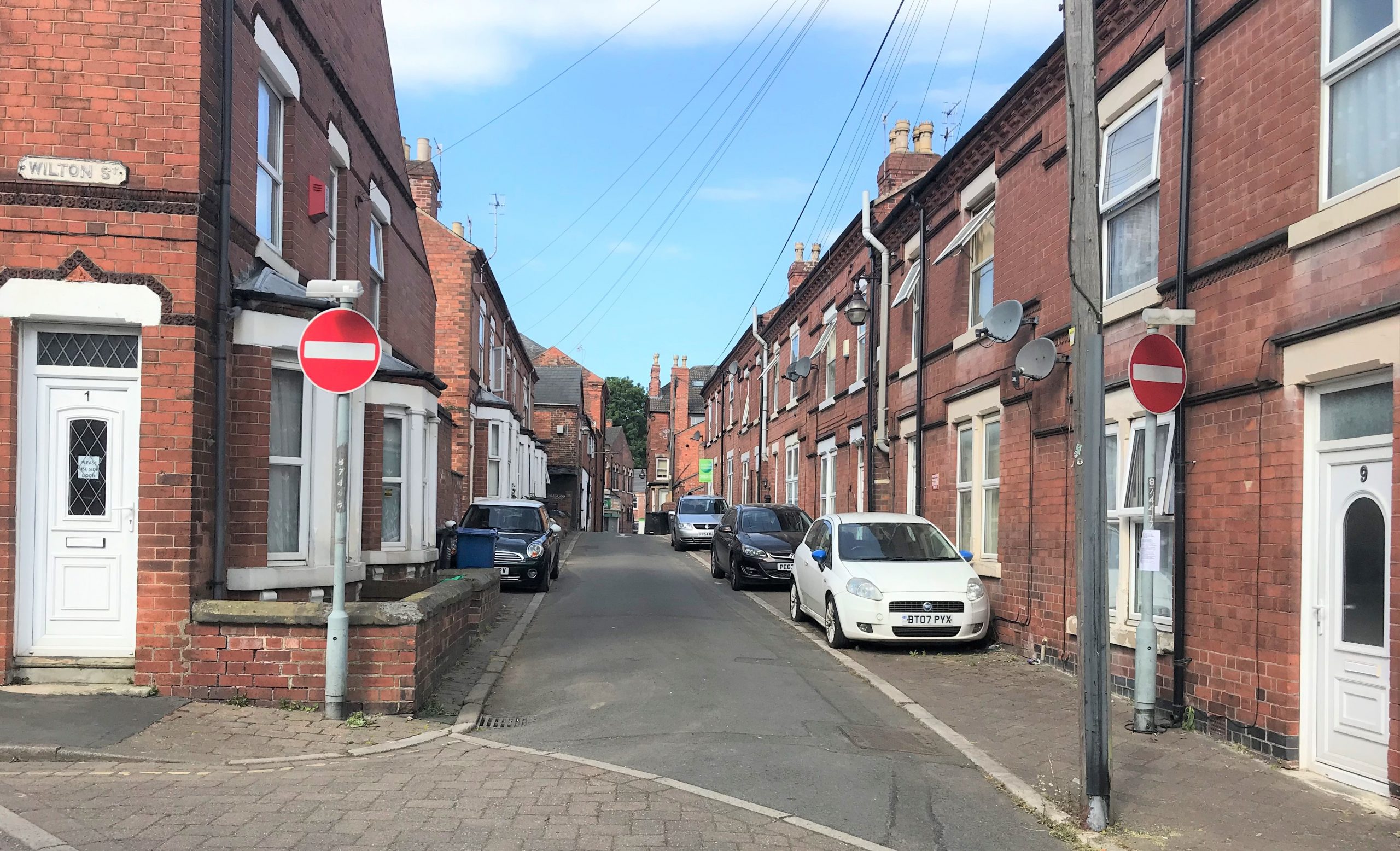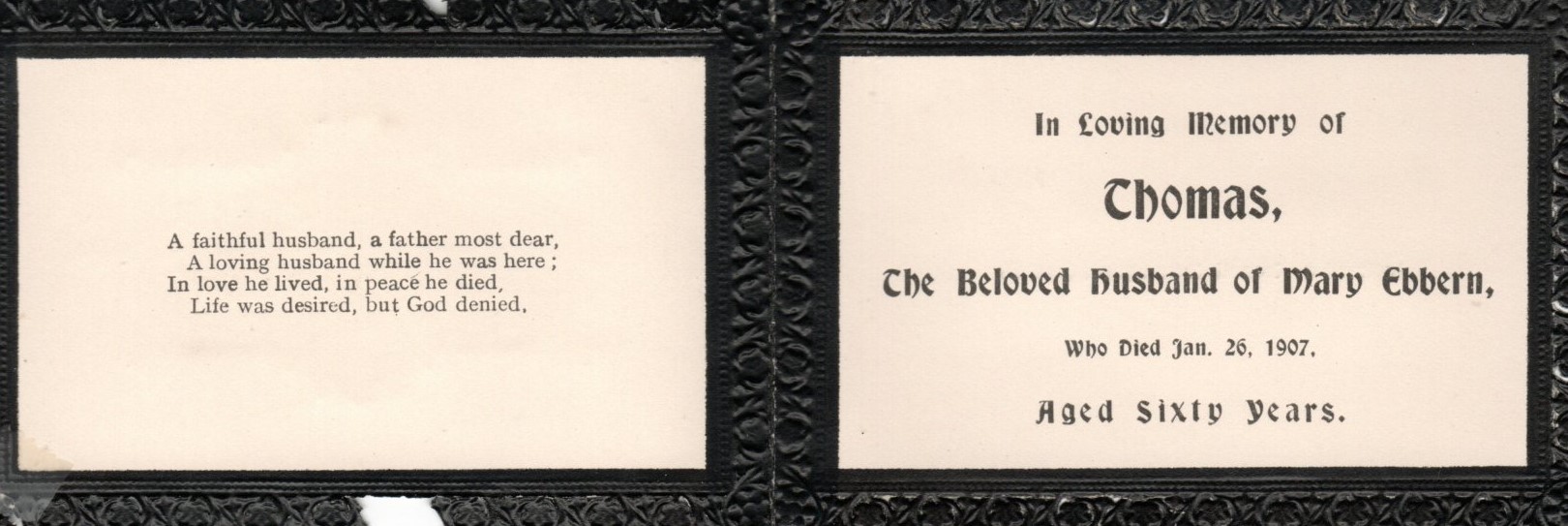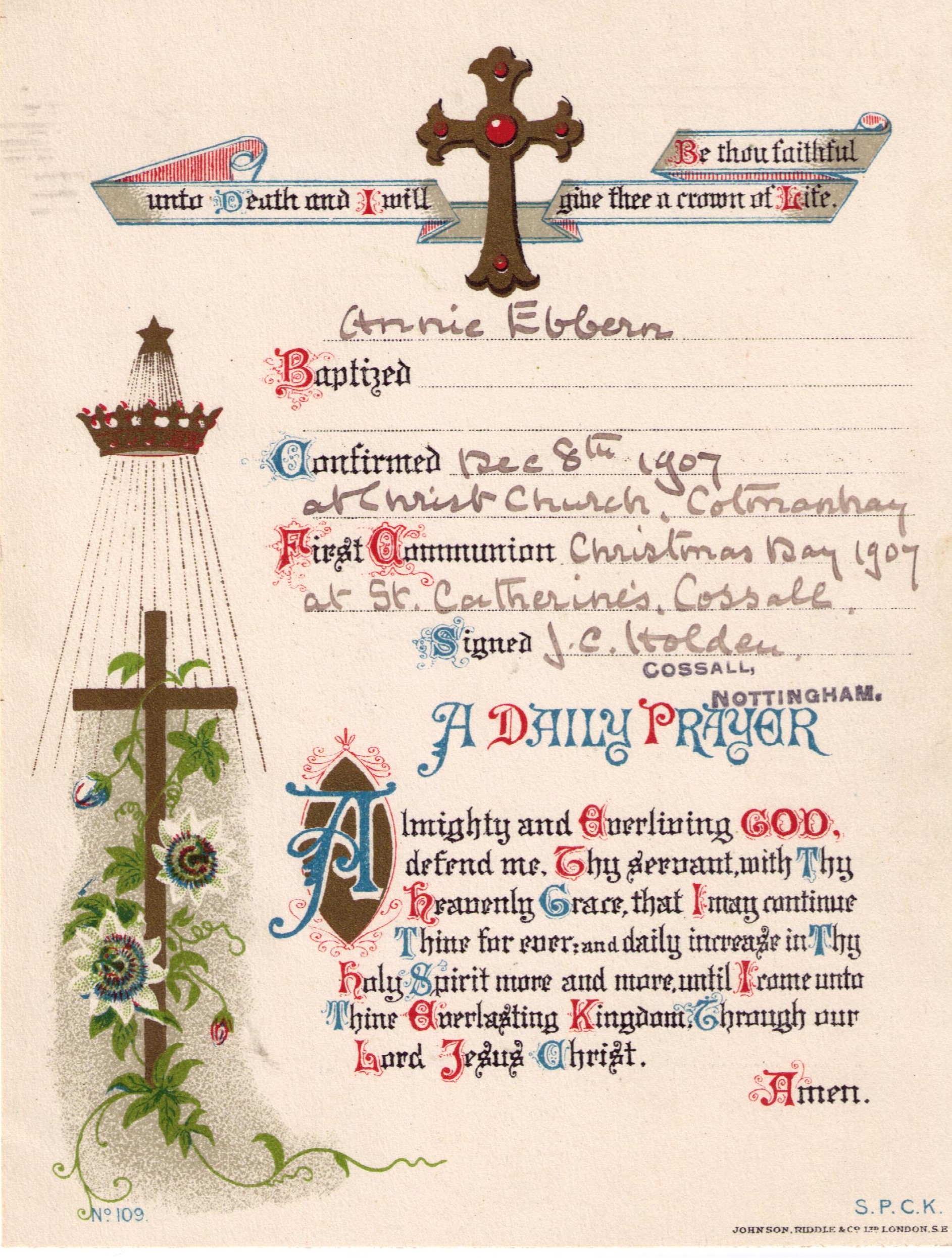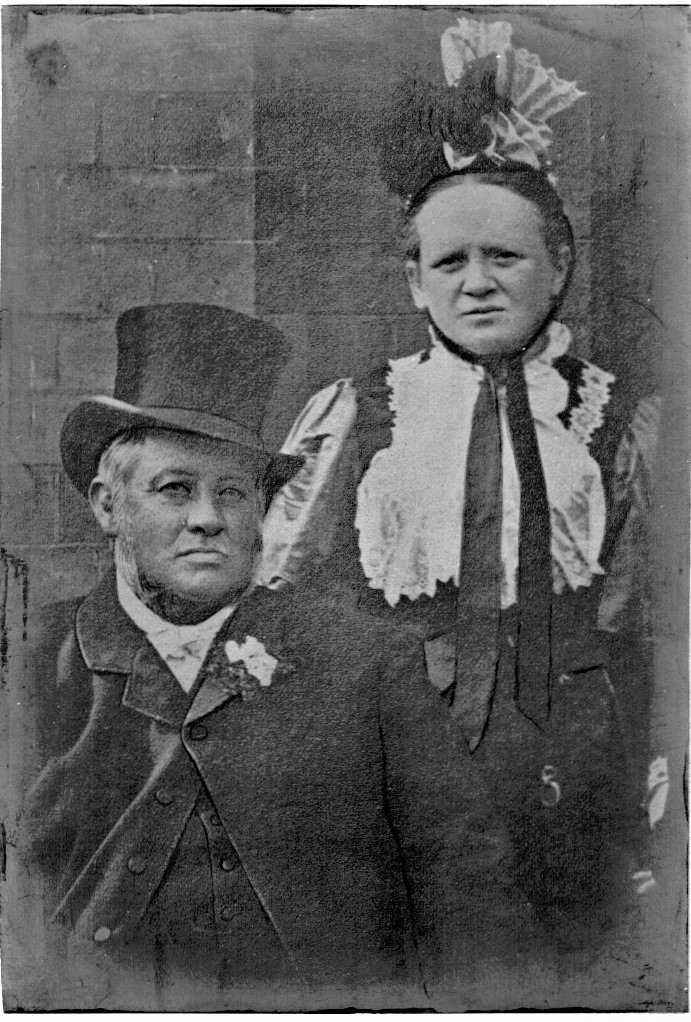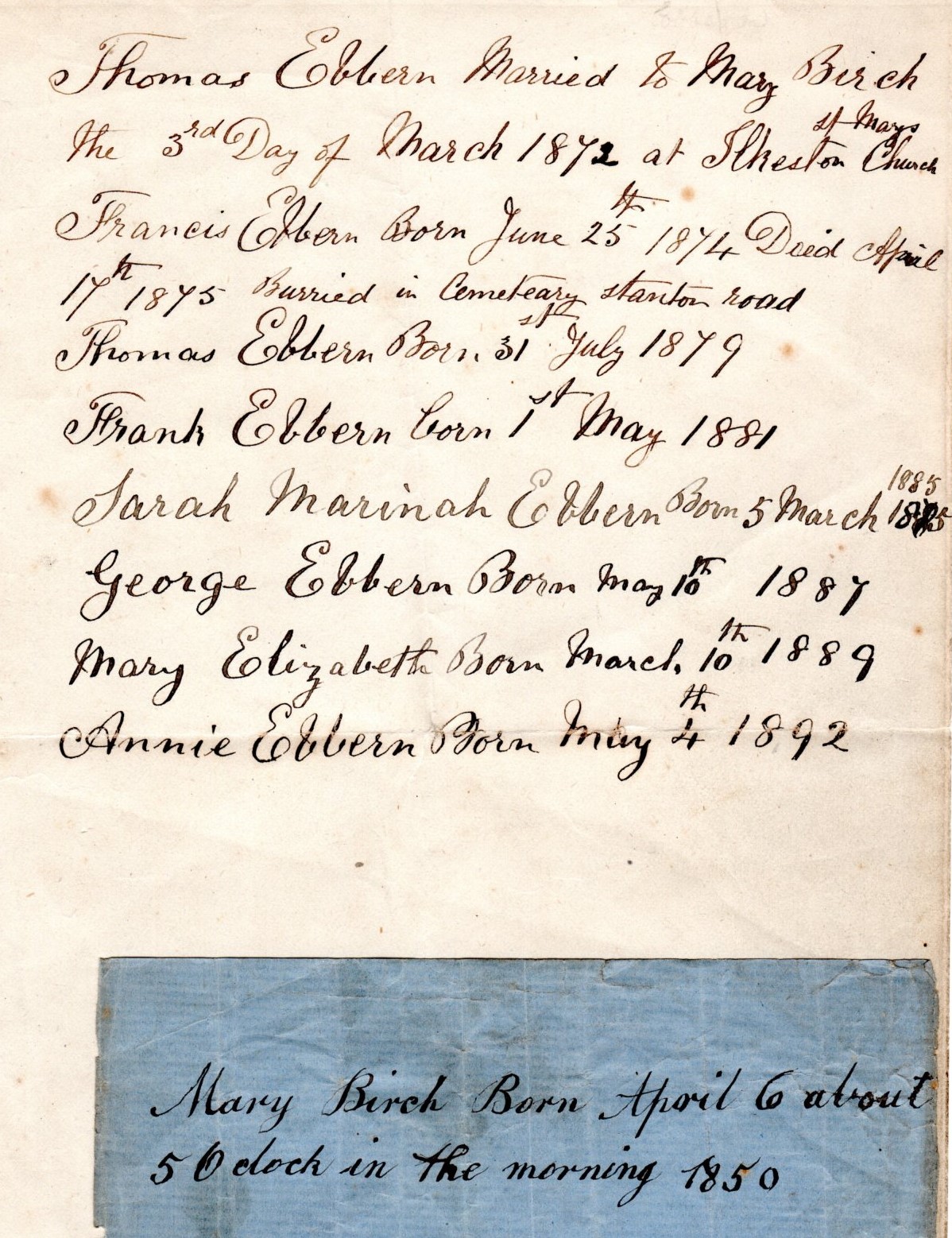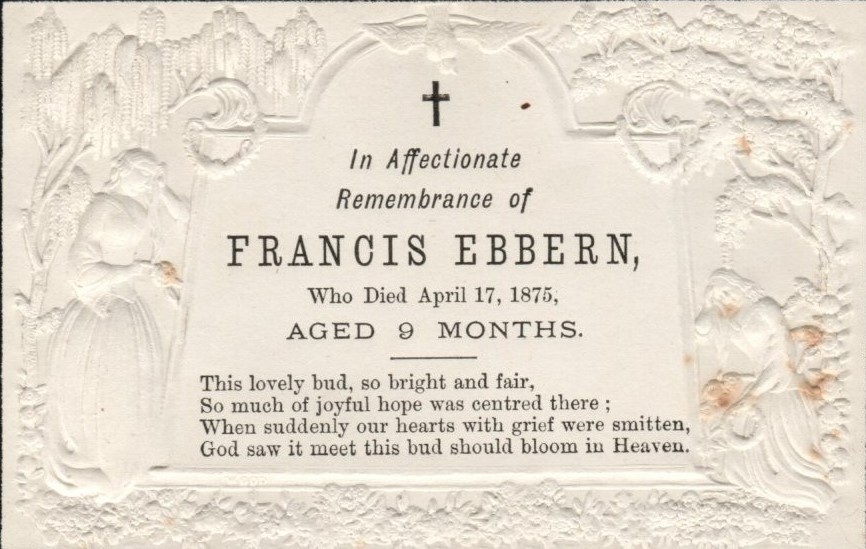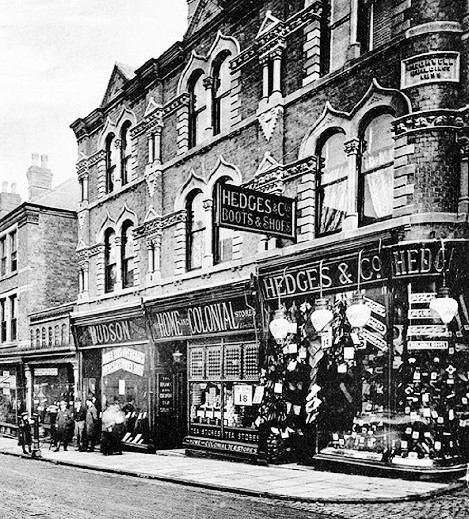We move on from the Poplar Inn but still considering one of the Ebbern clan.
Adeline’s recollection is that “Tom Ebbern married Mary, the youngest daughter of John Birch, joiner.“
And indeed the marriage register of St. Mary’s Church records that Thomas Ebbern married Mary Birch, daughter of South Street joiner John and Sarah (nee Wagstaff) on March 3rd 1872. At this time Tom was living with his mother on the Poplar Inn site and trading as a butcher.
——————————————————————————————————————————————–
The Thomas Critchley Estate: Part 2
We now continue the story of William Riley’s premises at the north corner of Bath Street and North Gate, as revealed in the documents of Jim Beardsley. And see how Thomas Ebbern fits into it.
If you recall, we had arrived at 1862 and the bankruptcy and subsequent departure of butcher William Riley and his family from Ilkeston.
1862: John Adsetts takes control
Six months after the Bankruptcy sale of butcher William Riley’s premises — on January 13th 1862 — John Adsetts (remember him ?) filed a Bill of Complaint in the High Court of Chancery, against Joseph Shaw, William Sampson, Herbert Wright, John Harris, Philip Potter, and Robert Harrison — this simply set out his case for compensation, against these men. Added to the list were Amos Trueman and Henry Bostock (presumably of Ilkeston) who had belatedly been drawn into the imbroglio after they purchased part of the Riley property in the bankruptcy sale. Based upon previous mortgage ducuments however, both Herbert Wright and William Sampson claimed that they were owed large sums of money from the estate. As parts of William Riley’s property remained to be sold it was feared that any proceeds would not cover what these men had initially loaned — so what followed was each man pleading his case for repayment. An agreement was reached whereby John Adsetts would receive proceeds from the property sale and from that sum he would then pay a stated (small !!) portion to William Sampson, another (much larger !!) portion to Herbert Wright, and the final residue would be lodged with the Official Assignee and the two Assignees forthe Creditors. All this was agreed and done by John Adsetts.
(Lo and behold !! Just over two weeks after this, Joseph Shaw appeared at Derby Police Court, not in his usual role, but in the dock, standing accused of forgery. This alleged crime had taken place two years earlier –in April 1859 — and centred around a ‘forged’ mortgage deed and a land conveyance involving Thomas Hives of the Rutland Arms, combined with the possible defrauding of his own client John Adsetts. But in subsequent court appearances, as these cases proceeded, Joseph faced more and more charges — eleven in total — and now Herbert Wright, in his role as solicitor, was brought into the cases. Eventually, at Derby Crown Court, at the end of March 1862, Joseph pleaded ‘Guilty’ to all the charges against him. He was sentenced to 15 years in prison. One month later he was struck off the roll of the Court of Queen’s Bench.)
1863: an agreement is reached
On January 13th 1863 the ‘great and good’ who had been embroiled in this saga came together. The list included John Harris esquire of Nottingham; Philip Potter; Robert Harrison the younger; William Sampson; John Tompson, a maltster of Erdington near Birmingham; Herbert Wright; and John Adsetts. An agreement was drawn up in which John Adsetts now took possession of the Riley hereditaments, after having ‘paid off’ the other interested parties.
This agreement described William Riley’s premises thus …
“a Butcher’s Shop, Stables, Gighouse, Slaughterhouse, Cowhouse and Piggeries, situate in Bath Street in Ilkeston … now in the occupation of William Riley, and bounded on the West by Bath Street, on the North by premises belonging to … Mr. Twelves (sic .. it should be Twells), on the East by … (the Garden Ground, later described), and on the South by a road or way leading to North Street. (this road or way would be North Gate), and containing in the whole six hundred and forty four square yards or thereabouts.”
There were then “two pieces .. of Garden Ground at the rear .. of and adjoining the premises of William Riley, containing nine hundred and fifty four square yards or thereabouts, and bounded on the West by the said premises, on the North by land and premises belonging to the Duke of Rutland, on the South by the road or way leading to North Street, and on the East by a street called Belvoir Street.”
A drawing was made of the premises which John Adsetts now took possession of; it appeared on the rear of the document, and matched the written description above. Time has not been too kind to it, but I include it below. Some of the writing you may not be able to read, so I have made notes below the sketch.
Sketch of the Riley premises made on a Grant and Release, dated January 13th 1863
Reading from the left, which of course is West, you can see on the premises, a shop, parlour, yard entrance, houseplace, house, garden, slaughter house, stables, yard entrance, coach house.
The dimensions are clear, as are most of the features bounding the Riley premises, except, perhaps, Mr.Twelves in the North-west, and Belvoir Street in the East (This later became Wilton and Durham Streets).
1863-1881: The butcher’s shop is occupied
John Adsetts was not a butcher and continued to live in Duffield. By 1870 the shop was occupied by butcher Frederick Fletcher, who appears on the 1871 census at ’79 Bath Street’; he must have been renting it from John Adsetts. And at some time before 1881 Thomas Ebbern appears to have moved in to rent it.
John Adsetts made a will on February 15th 1875 in which he left his Ilkeston property to his daughter Anne, who had married a prosperous farmer, George Milnes of Ash House, Turnditch, on December 24th 1857. (The latter died on April 26th 1871.)
John Adsetts died on November 3rd 1875 and his will was proved on January 4th 1876. Anne succeeded to the property though she continued to live at Turnditch. On November 2nd 1881, she agreed to sell the property (shown below) to her tenant Thomas Ebbern for £900.
Plan made by surveyor George Haslam for a Conveyance of Property in Bath Street, dated November 2nd 1881, between Anne Milnes and Thomas Ebbern.
1881- 1899: Thomas Ebbern at 79 Bath Street
And on the following day — November 3rd 1881 — Thomas Ebbern signed a mortgage agreement with Roby Liddington Thorpe, solicitor of Nottingham, to raise a total of £1000 on this property.
On May 2nd 1883 Thomas repaid £200 of the principal sum. He continued to meet the interest payments on the remainder.
In a Transfer of Mortgage dated December 12th 1884, the mortgage, now valued at £800, passed to Mrs Eleanor Plowright of 44 Sandon Street in New Basford. And, in a continuation of the same document but dated September 29th 1891, Thomas Ebbern paid off the outstanding loan of £800 and so reclaimed full ownership of the Bath Street property. It had a frontage to both Bath Street and North Gate.
This photo above is from the family collection of Pam Bates … unfortunately damaged with the passage of time. And the one below is from Andrew Knighton‘s collection of postcards. On the back, written in pencil, are the words ‘Annie Ebbern’s butchers shop, Ilkeston‘. Andrew estimates that the card was published about 1910, and was copied from an old damaged photo, possibly from the early 1890’s. (like the one above ?)
He comments “I have a number of local trade directories and checked through these and Thomas Ebbern was trading from 114 Bath Street from at least 1893 to 1900 which I think would be where Northgate Street meets Bath Street. However, the photograph doesn’t appear to show the gradient you would expect which is a bit of a puzzle. The corner of Northgate Street/Bath Street was re-developed just before 1900 (evident from the date stone on the corner building where I think 114 Bath Street is) and so I think this postcard which I estimate was published around 1910 was copied from an old damaged photo possibly from the early 1890s. Apart from the lack of a gradient being evident, I wouldn’t really doubt it could be 114 Bath Street”.
By 1894 the butcher’s shop address was 114 Bath Street. In the late 1880s the premises in Bath Street had been renumbered. All those on the west side were now odd numbers. Properties on the east side, including the shop of Thomas Ebbern, were now even numbers.
From the collection of Pam Bates
In February 1899 the Ebbern premises were advertised as for sale by auction at the Rutland Hotel on March 13th. The property was described as a freehold messuage/dwelling house, butcher’s shop with stable, slaughter-house, cowhouse, and piggeries. There was also an area of building land of 1580 square yards approximately, from Bath Street to North Gate.
The premises at the corner of North Gate and Bath Street were sold to draper William Gibson, of Wortley House, Ilkeston, for the sum of £1710. The property was described as being 570 square yards, which would make it slightly less than the area shaded blue in the above plan, and appearing on the west side of the property. It was described as ‘bounded on the West by Bath Street, on the North by property belonging to the Duke of Rutland and leased to Thereza Chapman, on the South by North Gate, and on the East by an intended road or passageway of four feet in width.” (paraphrased).
At the same time Thomas sold to William the other two areas along North Gate, to the east of the shaded area up to Durham Street (formerly Belvoir Street), for £300. You can see, in the sketch below, that it bears the name of William Gibson, but what it doesn’t show is that the areas extended up to Durham Street.
At times William could get ahead of himself: for example, on one occasion in November 1900 he found himself at the Petty Sessions, accused of breaking Bye-law 26. He had allowed one of his houses in Northgate to be occupied without the requisite certificate from the Borough Surveyor. Fined 10s plus costs — and don’t do it again !!
Above …Sketch included in a Conveyance of Property between Thomas Ebbern and William Gibson, dated May 15th, 1899.
Below … what the area looks like today (2021), looking westwards towards Bath Street; William Gibson’s property on the right
—————————————————————————————————————————————————
1899: Thomas Ebbern leaves Ilkeston
Thomas and his wife retired to Cossall where he died at Poplar Farm on January 26th 1907.
And on Christmas day of that year his youngest child, Annie, received her first communion at St. Catherine’s Church, Cossall.
Confirmation and Communion 1907 .. courtesy of Pam Bates
Thomas’s wife, Mary, died in 1931, aged 80, and is buried at Kirk Hallam Parish Church with many of her Birch ancestors.
—————————————————————————————————————————————————
Tom and Mary Ebbern (from the family collection of Pam Bates)
—————————————————————————————————————————————————
Almost a year after the Ebberns left Ilkeston — on April 27th 1900 — a lease agreement was signed between William Gibson and the Home and Colonial Co. Ltd. of 2 & 4 Paul Street, Finsbury, whereby the latter would rent the ‘newly erected shop and dwellinghouse ’with its yard etc. on the corner of Bath Street and North Gate, and called Cromwell Buildings. The term of the lease was 21 years, with a rent of £85 pa., and all the usual conditions agreed between a landlord and tenant were laid out. (It would seem that the Home and Colonial Co. Ltd. extended their stay at the premises in November 1922 at what was then 114 Bath Street.)
On October 15th 1900, a similar agreement for the same period and at the same rent was made between the landlord and John Wesley Hedges and Arthur Tollington — trading as Hedges & Co. boot factors of 117 Grafton Street in Leicester.
Both can be seen in the photo below, housed in Cromwell Buildings and dated about 1901.
On March 25th 1901 William Gibson mortgaged this property for £5000 with John Thorpe Perry, William Thorpe Perry and John Alfred Gotch. And by this time the third part of Cromwell Buildings had been tenanted by Messrs Hudson & Co., Clothiers, which can also be seen in the photo.
Also included in the mortgage agreement was William’s other North Gate Street property, which stretched from the Cromwell Buildings, eastwards to Durham Street (formerly Belvoir Street), and included nine houses, then occupied by the families of William White, William Holden Cockeram, Frederick Savage, Selina Lewis, Richard Duro, Henry Bower, ? Whitehead, James Meakin and Charles Smith. These were Numbers 7 to 15 and included one shop. Strangely in the agreement, North Gate Street was named as Litchfield Street although all but one of these occupying households are listed on the 1901 census, living in Northgate Street.
The following day the mortgage was transferred to the Nottingham Joint Stock Bank Ltd, and then, almost a year later it was reconveyed back to William Gibson after he paid off the mortgage debt, with interest.
You can identify the whole of this area — coloured blue, yellow and green — on George Haslam’s sketch map above.
And there, at the end of the Victorian era, we leave the story of Thomas Critchley’s estate … but we don’t leave the Ebbern family just yet.
————————————————————————————————————————————————
We have time to look over a very interesting ‘Family Photo Album‘. compiled by Pam Bates, which links the families of Ebbern, Paling, Robinson, Maltby and Sudbury.
——————————————————————————————————————————————-
Or we could continue our walk down Bath Street, to meet Samuel Whitehead, hero of Waterloo. The Grand Tour

